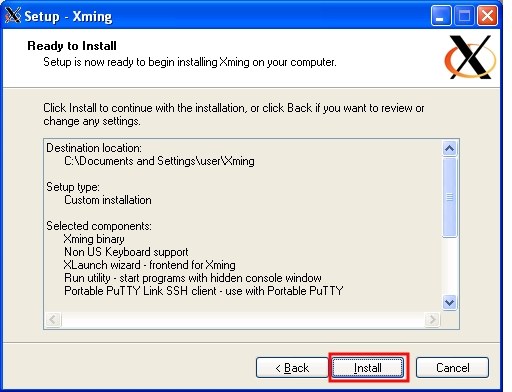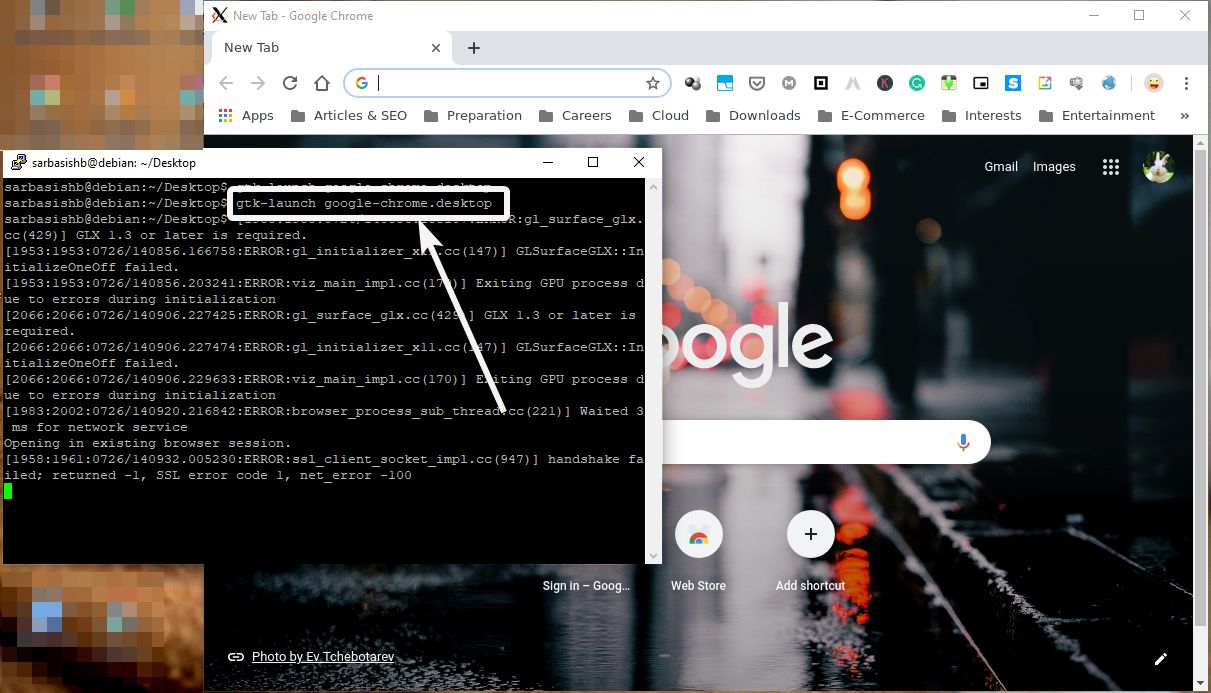- Xming v.6.9.0.31Integrate PulseAudio with Xming/XLaunch (fun, but a distraction, and I need to check all dependent libraries are compilable with MinGW). Fix a borders black, corrupted or missing rendering error in -mwextwm mode e.g. with xcalc and oclock (tricky).
- Xming X Server for Windows v.2.33Xming is the leading X Server for Microsoft XP/2008/Windows7. It is fully featured, small and fast, simple to install and because it is standalone native Microsoft Windows, easily made portable (not needing a machine-specific ...
- VcXsrv Windows X Server v.1.0Windows X-server based on the xorg git sources (like xming or cygwin's xwin), but compiled with Visual C++ 2010. Source code can also be compiled with VS2008, VS2008 Express Edition and VS2010 Express ...
- MobaXterm v.7.4MobaXterm is a set of Unix commands (GNU/Cygwin) included in a single portable exe file. MobaXterm integrates an X server and several network clients (SSH, RDP, VNC, telnet, rlogin, sftp, ftp, ...) accessible through a tab-based terminal.
- SpeedLinux v.1.0SpeedLinux is a customized coLinux. coLinux is not a VM but it can be used in the same way. Installation of Speedlinux results in a complete LINUX System with X server running side on side with Windows on a single PC.Beginning with Version ...
- VcXsrv Windows X Server Windows X-server based on the xorg git sources (like xming
- Xming X Server for Windows Xming is the leading X Server for Microsoft
- MobaXterm MobaXterm is a set of Unix commands (GNU/Cygwin) included in
- SpeedLinux SpeedLinux is a customized coLinux. coLinux is not a VM but
- Xming Integrate PulseAudio with Xming/XLaunch (fun, but a
Download Xming - Application that enables you to obtain a server port for Windows system. And comes with a version of PuTTY's plink.exe. The Xming project additionally offers a portable version. Xming portable PuTTY is a Shareware software in the category Miscellaneous developed by Colin Harrison. The latest version of Xming portable PuTTY is 7.3.0.26, released on. It was initially added to our database on. Xming portable PuTTY runs on.
Xsrv+PuTTY on a Stick
In furthering our goal of enabling users of the SCRC analysis software toanalyze anywhere,we've put together a compact, portable set of Windows software to allow easysetup of remote X Window sessions via SSH.It's actually two packages combined together:the VcXsrv X Window serverand the PuTTYterminal emulator and SSH client.We've configured these so they can be run from a portable USB memory stick,so we call this setup Xsrv+PuTTY on a Stick.However, it can also be setup on any Windows hard drive.Our intent was to put together a small and portable X server that was:
- secure and reliable,
- easy to use and configure,
- lightweight(small and doesn't need a complex or lenghty installation),
- self-contained/portable(could be run from anywhere including a memory stick), and
- free in both senses of the word (no cost, no restrictions).
To accomplish this, we put together two packages and some of our ownconfiguration files, to make it all work together nicely.The major component is the X Window server.Of the leading free X servers for Windows, we chose VcXsrv over Cygwin/Xbecause it ismuch more self-contained, which makes it more portable.We had used Xming in the past, but the free version of it hasn't been updatedin almost 10 years.We added in an entry to the system.XWinrcconfiguration file for launching a new PuTTY session.We used a modified version of PuTTY calledPuTTYtray,again for portability,mainly to avoid PuTTY's use of the Windows registry for its configuration.Other PuTTY variations are available that use configuration files insteadof the registry, but we settled on PuTTYtray because it seems to beactively maintained (some others like portaPuTTY use older PuTTY source anddon't have the latest security fixes), and also because it can transferconfigurations from the registry to files and back again.Finally we set up Session profiles for our systems, and default settingsthat include all the features and options we like to use to connect to oursystems.

You can download Xsrv+PuTTY on a Stick from here:Extract the ZIP file into the root folder of your USB stick, or into any folderon your hard drive where you want to put it.(The Desktop works well for this.)It will create a sub-folder called VcXsrv when you extract it.That's all there is to installing it.To run it, double-click on the icon namedStart VcXsrv+PuTTY.cmd.

Update - June 1, 2018:The VcXsrv.zip package was updated on our web site to include the latestrelease of VcXsrv(version 1.20.0.0 released June 1, 2018)and the latest stable beta release of PuTTYtray - 0.67-t029.If you're running an older download of VcXsrv.zip, or Xming.zip,we recommend you download VcXsrv.zip and try it instead.It fixes a font loading problem in the 1.19.2.0 release, and has securityupdates in its SSL libraries, as well as a number of other bug fixes.We used the 32-bit version of VcXsrv, not the 64-bit version, so that itwill run on more systems.We also make a 64-bit package for use with WSL installations, which is usedby one of our installation scripts for WSL systems, as the 32-bit of VcXsrvversion can't launch a bash.exe session from the menu.
| Starting Xsrv+PuTTY from the VcXsrv folder |

| VcXsrv task bar icon and pop-up menu |
This command file starts up VcXsrv in the background, using a numberof configuration options that make it behave the way we want, most notablythat it runs in a rootless, multi-window configuration which allows X Windowapplications to co-exist with Windows applications on the same desktop.
Once started, VcXsrv puts an X icon in the task bar.Right-click on this icon to get VcXsrv's pop-up menu, from which you canselect New PuTTY Session... to start up a terminal connection toone of the capture and analysis systems.This brings up PuTTY's configuration window, from which you can selectand start up a new terminal session, as well as set up and save yourconfiguration options for these sessions.Our VcXsrv.zip package comes with pre-defined sessions for all of theSCRC's current data capture and analysis systems, which can be used as-isto connect to our servers, or you can use these as a starting point fornew system configurations.To connect to one of these servers, simply double-click the server namein the list of stored sessions.A double-click will do the same as single-clicking the name, then clickingon Load and then Open.

| PuTTY Configuration and Session selection window |
Important note:PuTTY does not load any saved sessions from file automatically at start up.Unless you explicitly select and load one, it will start up with its ownbuilt-in default settings (not the Default Settings from file), which don'tenable X11 forwarding through SSH so they won't support X Window applications.So, to connect to a different system than the ones in the sessions alreadyconfigured, load one of the existing saved sessions from file, change thehost name (and login username from the Connection/Data if necessary),then save the session under a new name.Then any time after that, you just need to double-click on the saved sessionname to open that session on the saved host name.This is described in more detail below.
Once you've opened a session, the PuTTY window will ask you for a password.After that, you should get a command prompt in that window, allowing you toenter commands.Using a remote X session, the mouse buttons should work as expected,though it's possible that Windows won't support the middle button transparently.Any X Window applications that you run from the xterm window, includingmost programs in the analysis software suite, should open their own windowsright on your desktop, co-existing with any Windows application windows youmay have running.
Vcxsrv Portable
All these sessions are set up to enable X11 forwarding through an SSH tunnel.This allows secure access to X Window applications on our servers fromjust about anywhere, even from PCs behind firewall systems, or on publicnetworks.The first time you connect to a new system, PuTTY will pop up aSecurity Alert window, telling you that the server's host key is notcached.This is a security feature that allows PuTTY to confirm that it is indeedconnecting to the system you want.It's a good idea to establish your first connection while on a secure network,so you know you're getting the real deal.Click on the Yes button to cache the new key.PuTTYtray will cache new keys in the folder VcXsrvsshhostkeys, unlessearlier PuTTY host keys were previously cached in the registry.On subsequent connections, PuTTY will see that the host key from theconnection matches the one it has cached, so it knows that the server isnot a fake, even when connecting from an unsecured public network.All data passed between PuTTY and the server will be encrypted, including youruser name and password, as well as all data between your PC and any X Windowapplications you run on the server.
It's very easy to change your session configurations,or to set up new saved sessions in PuTTY as well.Use one of the existing sessions, or the Default Settings,as the starting point.Single-click on the name of one of these, click on Load,and then browse through the options by selecting categories from theCategory pane on the left.You can turn off X11 forwarding for a session, to support plain-textterminal sessions with ssh servers that don't support X11, by clicking onthe + sign next to SSH, under the Connection category,then click on the X11 category under SSH, and finally uncheck the boxlabeled 'Enable X11 forwarding'.(Note: only uncheck this option if you don't want to useX Window applications on that system, or if it doesn't support them.To use X Window applications for a session, make sure the'Enable X11 forwarding' option is checked.)To use a different user name than 'exp', which we commonly use on ourservers, select the Data category under Connection, and change or clearthe text box labeled 'Auto-login username'.If you leave this field blank, then PuTTY will ask you for your usernamebefore you get the password prompt, whenever you open this connection.There are many more options as well, including how the Backspace key andthe system bell are handled, the font and colours used, the initial windowsize and resizing behaviour.When you've set these as required, go back to the Session category at the top,and change the Host Name (or IP address) for the connection.Then, enter the session name (usually the host name) in the 'Saved Sessions'text box, and click on the Save button.The new session name should appear in the list below.By default, PuTTYtray saves sessions in a file (when 'Sessions from file'is selected), and these will be stored in the VcXsrvsessions folder.If 'Sessions from registry' is checked before saving, they will go in theWindows system registry instead.For portability, e.g. if you're using a USB memory stick, make sure you'resaving and loading sessions from files.
When you're done running your X Window sessions, you should close things up.Begin by exiting all your running X applications, or closing their windows.Then logout from all your PuTTY windows, usually using Ctrl-D,or the exit or logout command.Finally, when all the X and PuTTY windows are closed, you can exit VcXsrvby right-clicking on its task bar icon, and selecting Exit.VcXsrv will ask to confirm that you want to want to exit, and shows thenumber of clients currently connected.You can usually ignore this number, if you've already saved your work andclosed all your windows - the number might include the SSH tunnels opened byPuTTY, which could still counted even after you've logged out.Click on the Exit button to close it all up, and then you canright-click on the 'Safely Remove Hardware' icon in the task bar to getWindows to finish with your USB memory stick so you can remove it.
See also: SCRC Software On-line Documentation,SCRC Software Tutorials
Xming Portable Putty 7.5 Download
